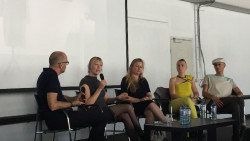Artists and scientists collaboration: learning from experience
In Ancient Greece there was a unity of arts, science, and philosophy. Future Emerging Arts and Technology (FEAT), a project about the role that art plays in science and innovation processes, tries to rediscover that unity. Through collaborations with Future Emerging Technologies projects (FET), the resulting emergence of original thought-provoking artworks aim to communicate with the general public within a friendly artistic space. This artistic space, such as an art gallery or a museum, is more accessible than the science labs. Therefore, discussing timely topics such as supercomputers, quantum physics, genetics and gen editing, or robotics can be done at a level where anyone can participate. During the Ars Electronica Festival in Linz, Austria, Erich Prem and Lucas Evers, FEAT project managers, moderated a panel discussion where artists Anna Dumitriu, Evelina Domnitch, Dmitry Gelfand, Špela Petrič and Miha Turšič, together with independent art and science researcher Claudia Schnugg, professor of media theory Ingeborg Reichle, and professor of philosophy of media and technology Mark Coeckelbergh analysed artists and scientists’ collaborations. During the discussion, the artists explained the fascinating process leading to the creation of their artworks as well as sharing some personal anecdotes, pain points and lessons learned from their collaborations with high-technology development projects around Europe. What makes the FEAT initiative interesting is that it is funded by a technology programme, not by an artistic initiative. 'Scientists want to see they have invited artists that are making things that are meaningful not only for arts but also for what they are doing,' said Lucas Evers. For Evelina Domnitch and Dmitry Gelfand, the experience of being able to choose from among five different quantum research groups was described as 'a tremendous luxury'. 'This unprecedented situation endowed us with a unique navigational capacity, leading not only to the creation of several fruitful artworks, but most importantly, to an ongoing endeavour which promises to be the most ambitious we have ever undertaken. For us, the FEAT experience was, undoubtedly, our ultimate and most serendipitous collaborative engagement,' said Domnitch. Similarly, Anna Dumitriu told that she 'really enjoyed the lovely relationship with the scientists, and getting the opportunity to make a piece that, for a long time, I’ve been fascinated about developing. What is sad is that the funding was limited, and I would love to take this further,' she said. 'A lot of the collaborations automatically lead to other ideas, but there’s no specific funding vehicle.' A solid ground of trust was a basic ingredient for successful collaborations. 'You need to establish trust between yourself and the scientist,' said Domnitch. 'They have to have this feeling that we at least have a basic understanding of what we’re dealing with, and after that they start trusting you.' It was agreed that one thing the scientists learned from the artists was to view their own work from a different perspective. And in cases, scientists learned about the existence of contemporary art reflecting on science, and artists creating artworks about technology. Another issue discussed was where to show these artworks, and the importance of working with institutions and museums that can exhibit them. According to Dumitriu, places like Ars Electronica allow installations where the most flashy ones will attract the public, but the quieter ones will go unnoticed. 'It’s different in a museum,” she said, “where people adjust lighting according to the piece, and it has a kind of curatorial process, where you get a designed space perfectly curated for your work.' Read more: http://www.featart.eu/index.php?id=69
Countries
Germany, Israel, Türkiye, United Kingdom

